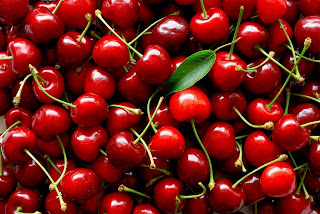
The cherry is a flowering plant that belongs to the rose family (Rosaceae). This plant is native to Europe, Asia and parts of North Africa. Cherry can now be found in temperate regions around the world. It cannot be grown in tropical areas because seeds need to be exposed to low temperatures to ensure germination. Sweet cherry, also known as wild cherry, and sour cherry are the most popular types of cherry. The sweet variety is mainly consumed raw. The sour variety is usually processed before consumption.
The average cherry tree has 7,000 cherries.
Cherry tree can grow 33 feet in height. Cultivated types are usually smaller.
A single tree can yield enough cherries to make 28 pies.
Cherry tree has silver-grey bark which is smooth in young plants. It becomes rough and covered with fissures in old trees.
The Japanese cherry blossom trees don’t produce fruit.
Cherry tree has long and slender green leaves that are oval in shape. They are serrated on the edges.
The most common type of sweet cherry is the Bing.
Cherry tree develops beautiful white flowers during the spring. Flowers are arranged in clusters. Insects are in charge for the pollination of cherry blooms.
The most common type of tart cherry is the Montmorency.
Varieties of cherry tree which develop pink flowers are grown in ornamental purposes. They do not produce fruit.
Tart cherries are used in baking because they hold their shape better than the sweet type.
“Hanami” is an ancient Japanese tradition of viewing cherry trees while they are in bloom. Japanese people track weather forecast which determines exact time of blossoming and they gather in large numbers in parks and temples to celebrate beauty of these flowers when they finally appear.
Door County was once the No. 1 grower of cherries in the U.S. During the 1950s, it produced 95 percent of the nation’s tart cherries, with more than 1 million cherry trees.
Botanically speaking, cherry belongs to the group of stone fruit (drupe). It has red, dark red or almost black smooth skin. Fleshy meat is moist and usually red or yellowish in color. Single, hard seed is located in the middle of the fruit. One tree produces around 7000 cherries per year.
In the Traverse City region alone, a whopping 4 million trees produce 150 to 200 million pounds of tart cherries annually.
Fruit production starts 3 to 4 years after planting. Tree reaches maturity after seven years.
Eau Claire, Michigan-known as the Cherry Pit Spitting Capital of the World-hosts the International Cherry Pit-Spitting Championship every year.
Cherry is rich source of vitamins C and dietary fibers. Sour cherry also contains vitamin A. Sour type is a bit healthier than the sweet type. Cherries have low caloric value. 100 g of cherries have only 63 calories.
The world record for cherry stone spitting is a whopping 93 feet 6.5 inches.
Cherries can be consumed raw, or as part of various sweet and salty dishes. They are also used for the manufacture of cherry wine.
Canada holds the record for baking the biggest cherry pie in the world.
Cherries are popular and often used in the industries of jams, jellies, ice-creams, marmalades, sauces and juices.
Kirsch was the name given to cherries that were first cultivated in Mesopotamia in 8 BC.
Scientific experiments showed that cherries have potential to reduce inflammation and sensation of pain in rats.
Washington grows an estimated 62% of U.S. sweet cherries.
Wood of cherry tree has fine structure and it is often used in the manufacture of furniture.
From the 1990s, Turkey produces 535,000 tons of cherries annually.
Around two million tons of cherries are produced each year. Turkey is the greatest manufacturer of cherries in the world.
Cherries are often used in the cosmetic and perfume industry because of their beautiful fragrance.
Cherry tree can survive and produce fruit around 100 years.










Wow, this blog post about facts is a breath of fresh air. In a world where misinformation is rampant, it’s refreshing to see someone emphasize the importance of evidence-based facts and logic. Thanks for spreading awareness and encouraging critical thinking.